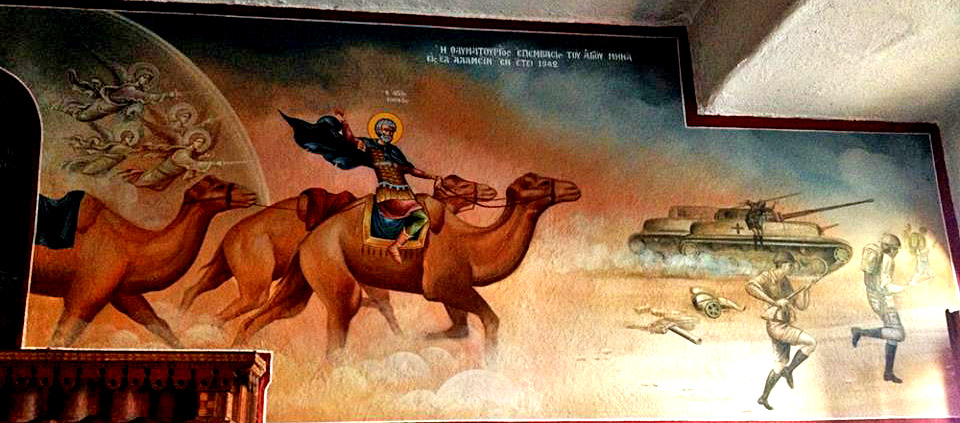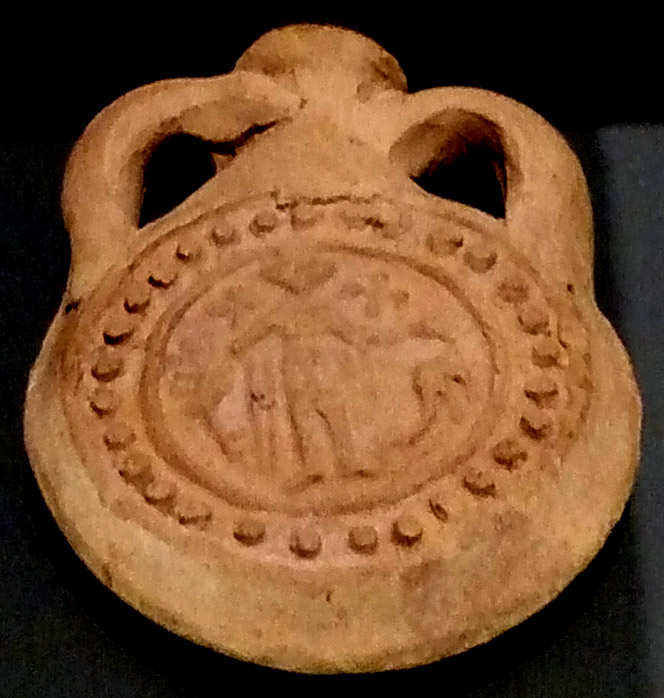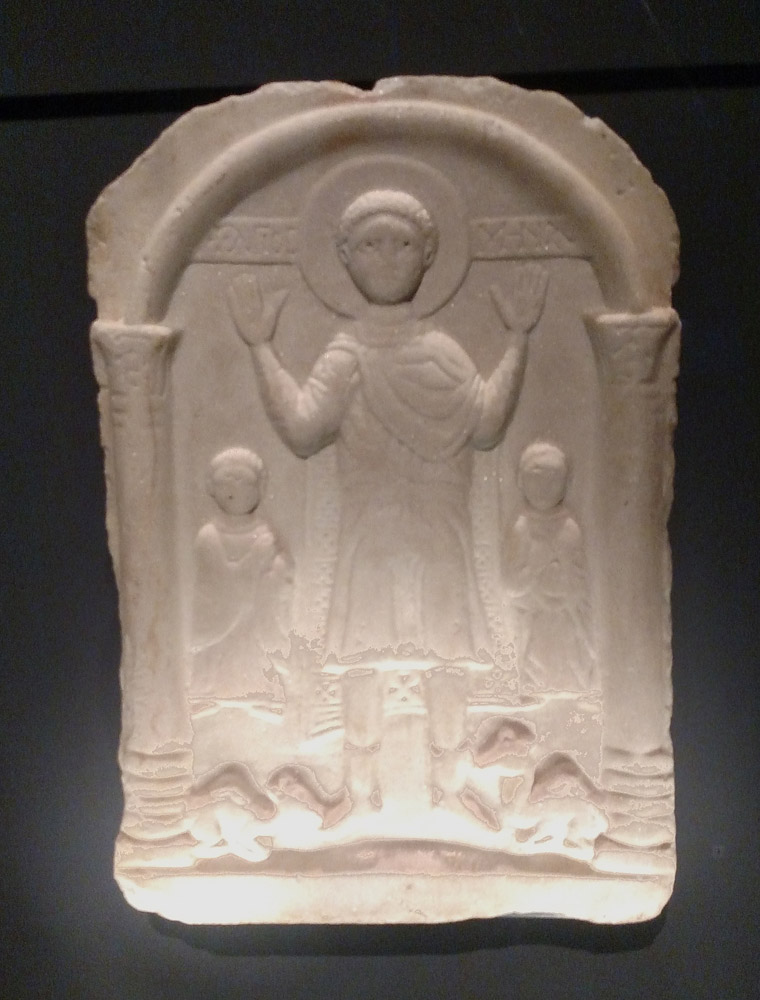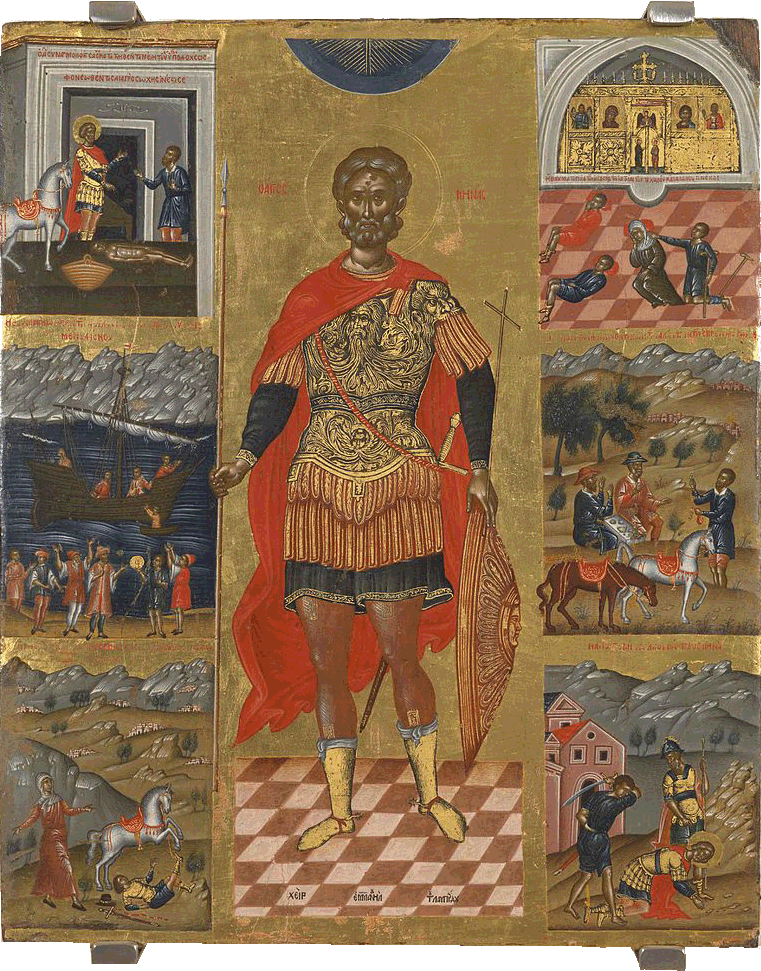Both traditions have St. Menas as a Christian in the Roman army stationed in Phrygia. He left the service because of the persecutions of the 303-313 A.D. and lived for a while as a hermit in the wilderness. Then he decided to make a declaration of his faith in the arena in Cotyaeum. For this he was beheaded and his body burned.2 In the Coptic legends that continue the story, Christian soldiers who had served with Menas took his body from Phrygia to Egypt. There a pair of camels took them to a place in the desert and refused to move on, so the soldiers buried the relics and returned to Phrygia. Later the place became a major destination for pilgrims, who believed in the healing properties of water flowing from a well there. They would take it home in ampullae bearing images of St. Menas and the camels (first picture at right). Many of these are now in museums around the world, along with souvenir plaques (second picture).3
The plaques may have been intended as memorials of the one that the soldiers' leader made for the return journey to Phrygia. On the voyage to Egypt they had been attacked by sea creatures with long necks like camels.
He made a picture of saint Mînâs the martyr on a wooden tablet, dressed as he had known him in the apparel of a soldier, with pictures of the beasts which resembled camels, at his feet, and they were worshipping him. And he laid that picture upon the body of saint Mînâs, to obtain his prayers, and then he took it with him that it might be unto him a means of deliverance and a place of refuge on the sea and in war.The plaques that I have examined do not have Menas in uniform, and the beasts are actual camels, not sea creatures. These differences may be due to the influence of the ampullae images.
By the 7th century the desert place had become a large city by the name of Abu Mena, with a monastery, a basilica, baths, and of course the holy well. It fell into desuetude after the Moslems conquered Egypt, but by then the cult of this saint had spread to many other countries.4
Some believe that on the eve of the Battle of El Alamein St. Menas appeared with his camels in the German camp, terrifying the soldiers and contributing to the Allied victory.5 The account is illustrated in a fresco in Mount Athos:

Prepared in 2018 by Richard Stracke, Emeritus Professor of English, Augusta University.

A souvenir ampulla from Abu Mena with the saint flanked by two camels and two crosses. (See the description page.)

A souvenir plaque from Abu Mena. (See the description page.)

A Greek icon of St. Menas, with miracles recounted in the Greek legends. (See the description page for summaries of the legends.)
MORE IMAGES
- 6th-8th century: Another ampulla with St. Menas, this one in New York's Metropolitan Museum of Art.
DATES
- Feast day: November 11
NAMES
- Also spelled Minas, Mina, Mena, Menna, Mennas.
- Menas's namesake, St. Menas of Constantinople, was the bishop who dedicated St. Sophia in 537.
- Cotyaeum is the modern Kütahya in Turkey.
BIOGRAPHY
- "Acta Sancti Menae Martyris Ægyptii." Analecta Bollandiana, III, 258-270. Also in a translation by David Woods as "The Passion of St. Menas of Cotyaeum (BHO 1250)".
- "The Passion of St. Menas of Cotyaeum (BHO 746)" (Coptic version of the above, adding the translation of St. Menas and development of his shrine).
- An Ethiopic martyrology has a shorter version of the above.
NOTES
1 The Orthodox Church in Abruzzo has posted a superb discussion of the various recensions and summarized the miracles recounted in them. It is in Italian, but Google's page translator does a good job of rendering it into English.
2 "Acta Sancti Menae Martyris Ægypti." Analecta Bollandiana, III, 258-270. Follow this link for an online translation into English.
3 "The Passion of St. Menas of Cotyaeum (BHO 746)." Catholic Encyclopedia, s.v. "St. Menas."
4 Catholic Encyclopedia, ibid. According to the Wikipedia article on St. Menas, flasks with his image have been found as far away as England and Germany and he is the patron saint of a number of German and Swiss towns. (Retrieved 2018-09-06 from this url.)
5 John Sanidopoulos, "The Miracle of Saint Menas in El Alamein in 1942." Posted to the website Mystagogy Resource Center on 2010-11-11, retrieved 2018-09-06. The web page says "El Alamein" means "place of Mena"; on Wikipedia it is said to mean "the two flags." The place is about 100 kilometers from the Abu Mena complex.